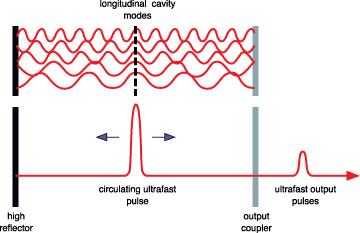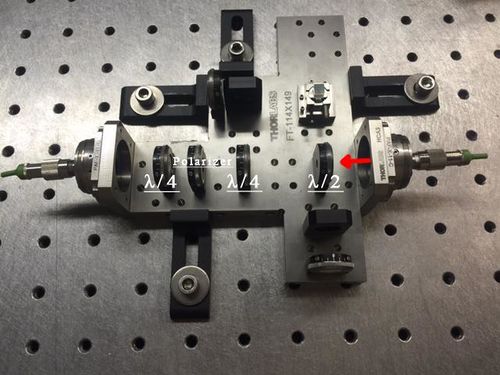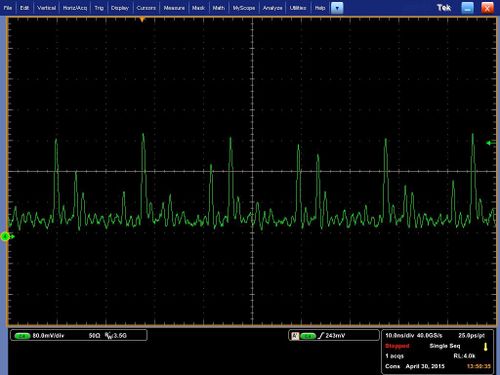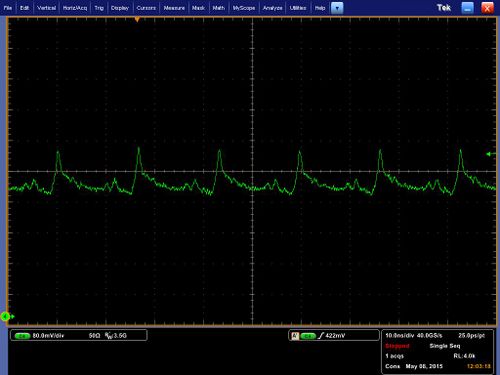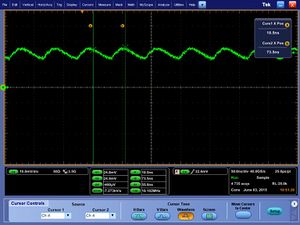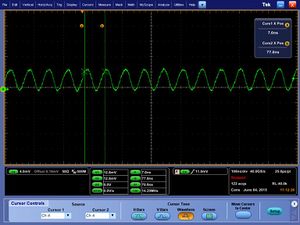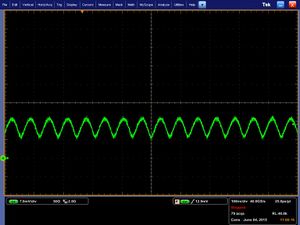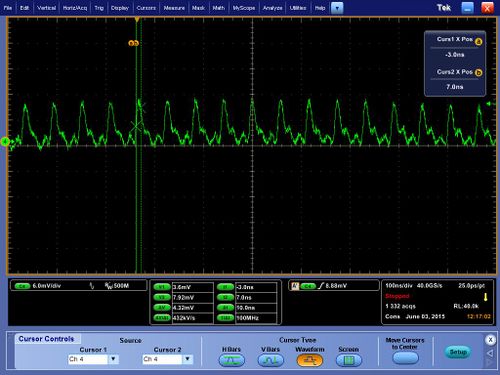Difference between revisions of "Mode-locked Erbium-Ytterbium Doped Fiber Laser"
Aplstudent (talk | contribs) |
Aplstudent (talk | contribs) |
||
| Line 10: | Line 10: | ||
[[File:ModeLocking.jpg|500px]] | [[File:ModeLocking.jpg|500px]] | ||
| + | |||
| + | == Passive Mode Locking == | ||
| + | |||
| + | Passive mode-locking techniques are those that do not require a signal external to the laser (such as the driving signal of a modulator) to produce pulses. Rather, they use the light in the cavity to cause a change in some intracavity element, which will then itself produce a change in the intracavity light. A commonly used device to achieve this is a saturable absorber. | ||
| + | |||
| + | A saturable absorber is an optical device that exhibits an intensity-dependent transmission. What this means is that the device behaves differently depending on the intensity of the light passing through it. For passive mode-locking, ideally a saturable absorber will selectively absorb low-intensity light, and transmit light which is of sufficiently high intensity. When placed in a laser cavity, a saturable absorber will attenuate low-intensity constant wave light (pulse wings). However, because of the somewhat random intensity fluctuations experienced by an un-mode-locked laser, any random, intense spike will be transmitted preferentially by the saturable absorber. As the light in the cavity oscillates, this process repeats, leading to the selective amplification of the high-intensity spikes, and the absorption of the low-intensity light. After many round trips, this leads to a train of pulses and mode-locking of the laser. | ||
== Additive-pulse Mode Locking == | == Additive-pulse Mode Locking == | ||
| Line 24: | Line 30: | ||
== The Kerr effect == | == The Kerr effect == | ||
| + | |||
| + | This is a passive mode-locking scheme in which nonlinear optical effects in intracavity components are used to provide a method of selectively amplifying high-intensity light in the cavity, and attenuation of low-intensity light. | ||
| + | |||
| + | This uses a nonlinear optical process, the optical Kerr effect, which results in high-intensity light being focussed differently from low-intensity light. By careful arrangement of optics in the laser cavity, this effect can be exploited to produce the equivalent of an ultra-fast response time saturable absorber. | ||
Nonlinear polarization generated in the medium, which modifies the propagation properties of the light. | Nonlinear polarization generated in the medium, which modifies the propagation properties of the light. | ||
Revision as of 10:40, 17 June 2015
Contents
High Power Pulsed Fiber Lasers
Ring cavity Er-Yb doped fiber laser showing optical bench for Kerr mode locking:
Mode Locking
Mode locking is a technique to create very short periodic pulses by locking modes in phase
Passive Mode Locking
Passive mode-locking techniques are those that do not require a signal external to the laser (such as the driving signal of a modulator) to produce pulses. Rather, they use the light in the cavity to cause a change in some intracavity element, which will then itself produce a change in the intracavity light. A commonly used device to achieve this is a saturable absorber.
A saturable absorber is an optical device that exhibits an intensity-dependent transmission. What this means is that the device behaves differently depending on the intensity of the light passing through it. For passive mode-locking, ideally a saturable absorber will selectively absorb low-intensity light, and transmit light which is of sufficiently high intensity. When placed in a laser cavity, a saturable absorber will attenuate low-intensity constant wave light (pulse wings). However, because of the somewhat random intensity fluctuations experienced by an un-mode-locked laser, any random, intense spike will be transmitted preferentially by the saturable absorber. As the light in the cavity oscillates, this process repeats, leading to the selective amplification of the high-intensity spikes, and the absorption of the low-intensity light. After many round trips, this leads to a train of pulses and mode-locking of the laser.
Additive-pulse Mode Locking
Nonlinear phase shifts in a single-mode fiber.
Pulses returning from the fiber resonator into the main laser resonator interfere with those pulses which already are in the main resonator.
Constructive interference near the peak of the pulses, but not in the wings, because the latter have acquired different nonlinear phase shifts in the fiber.
Peak of the circulating pulse is enhanced, whereas the wings are attenuated.
The Kerr effect
This is a passive mode-locking scheme in which nonlinear optical effects in intracavity components are used to provide a method of selectively amplifying high-intensity light in the cavity, and attenuation of low-intensity light.
This uses a nonlinear optical process, the optical Kerr effect, which results in high-intensity light being focussed differently from low-intensity light. By careful arrangement of optics in the laser cavity, this effect can be exploited to produce the equivalent of an ultra-fast response time saturable absorber.
Nonlinear polarization generated in the medium, which modifies the propagation properties of the light.
The refractive index for the high intensity light beam is modified according to Δn = n' ∙ I (with the nonlinear index n' and the optical intensity I).
Half wave plate rotates polarization so that the fast axis (highest intensity)is in line with the polarizer;
the signal passes through polarizer with the narrowing of the pulse due to extinguishing of the low-intensity tail-modes;
the quarter wave plate turns linearly polarized light into elliptically polarized light so that the non-linear rotation continues:
Optical bench showing half wave plate, polarizer, and quarter wave plate; another quarter wave plate has been inserted between half wave plate and polarizer to optimize the maximum intensity signal throughput:
Data
Some initial data: pulses occur one per every round trip time (based on length of all fiber elements), measurement of width of pulses is limited by detector resolution. The noise occurring due to imperfect mode interference is often comparable to the main pulses formed but highly unstable.
To stabilize the pulses part of the passive fiber was removed and isolator was spliced to the WDM. The pulses became more stable but not as narrow when signal is DC coupled:
The pulses are seen to be around 10 nanoseconds in width when the signal is AC coupled:


